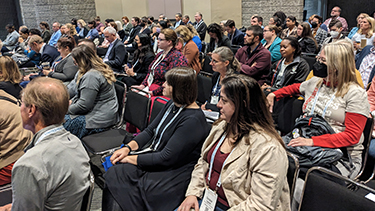It was standing room only for the “Communicating Public Health in the Post-Pandemic Era: Countering Misinformation and Disinformation” session on Tuesday, underscoring the topic as one of the biggest challenges facing public health today.
Session moderator Matthew Chamberlin, with the University of North Carolina Chapel Hill Gillings School of Global Public Health, opened the conversation with a brief definition of misinformation and disinformation and the difference between the two. Misinformation is having the wrong information, while disinformation is purposely spreading false information to reach a goal.

Lauren Baggett, with the University of Georgia College of Public Health, said trust in the scientific community was significantly damaged by the COVID-19 pandemic. According to a 2022 Pew Research Center study, public confidence in scientists and medical scientists decreased by 27.5% since 2020, a 14-point decrease among white adults and a five-point decrease among Black adults, with significant differences along political party lines.
Additionally, the percentage of the public who trust decisionmakers in Washington, D.C., to do the right thing most of the time has declined through the decades, falling from about 75% in 1960 to 20% in 2021.
“If the public doesn’t trust us (as science communicators), how can we reach them? We need to have one-on-one conversations to build trust,” Baggett said.
UGA does not have a science communications department or public health communications program, Baggett said, so she’s been building one from the ground up. She has been partnering with the university’s journalism program to work with students in public health programs to boost their communications skills, from social media to “traditional” media to in-person “elevator pitches.”
Social media platforms are diversifying, and more are available than in previous years. There are video-focused apps such as TikTok and YouTube, visually engaging apps such as Instagram, text-based platforms such as X and Threads, and other channels such as podcasts and blogs.
“However, there are fewer dedicated health and science writers; they’re disappearing from local papers,” Baggett said. She said there are fewer gatekeepers of scientific information because anyone can post on social media.
Sandra Albrecht, with the Mailman School of Public Health at Columbia University, is an epidemiologist by training but found herself venturing into social media during the COVID-19 pandemic. Albrecht, along with a small group of other women scientists and medical professionals, started the social media account “Dear Pandemic” on X, modeled after the popular “Dear Abby” column.
She said it began in 2020 with friends and family asking questions about navigating health and finding trustworthy information surrounding the pandemic, but it quickly grew, in both following and across other social platforms.
“We had a network of trust to start with, and it got bigger and bigger,” she said.
Due to the growth, the minds behind “Dear Pandemic” decided to shift to a new name more recently: “Those Nerdy Girls,” and they have been covering more topics such as reproductive health and aging.
Albrecht said one of the takeaways from creating and running the social account is that it is beneficial to amplify the positive information and the facts. She said when answering questions about the pandemic, the team didn’t give any credit to the disinformation, but instead focused on the positive things and the scientific facts.
“This led to a sense of optimism, which is something the disinformation sets out to destroy,” she said.
Photo courtesy of Mary Stortstrom.